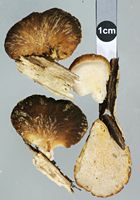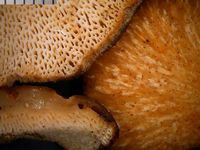|
 Polyporus hypomelanus Polyporus hypomelanus
SynonymsPolyporus grammocephalus
Tyromyces hypomelanus
Polyporus leprodes
BiostatusPresent in region - Indigenous. Non endemic
Images (click to enlarge)
Owner: J.A. Cooper | 
Owner: J.A. Cooper |
Article: Cunningham, G.H. (1965). Polyporaceae of New Zealand. New Zealand Department of Scientific and Industrial Research, Bulletin 164: 304 p. Wellington:.
Description: Hymenophore annual, solitary, firm and woody, laterally attached by a brief stem-like base. Pilei reniform, 2-5.5 cm wide, 2-4 cm radius, 2-4 mm thick; pileus surface ochraceous, darkening to reddish-brown peripherally, polished and glabrous; without a cortex; margin acute, entire, even; hymenial surface dark reddish-brown, even, with a lighter sterile border 1-2 mm wide. Pores ferruginous in section, 3-4 per mm, 200-350 µm diameter, 1-2 mm deep; dissepiments 100-350 µm thick, equal or with apices thickened, even. Context straw or clay colour, to 2 mm thick, of densely intertwined hyphae; binding hyphae 5-8 µm diameter, bovista type, freely branched, branches tapering, aseptate, lumena almost capillary; generative hyphae 3-4 µm diameter, walls 0.2 µm thick, branched, septate, with clamp connections. Hymenial layer to 18 µm deep, a dense palisade of basidia and paraphyses, soon collapsing. Basidia clavate, 12-20 x 6-8 µm, bearing 4 spores; sterigmata erect, to 3 µm long. Paraphyses subclavate, 10-16 x 5-6 µm. Spores narrowly elliptical, obliquely apiculate, 7-10 x 2.5-3 µm, walls smooth, hyaline, 0.1 µm thick.
Habitat: Bark of dead standing trunks, type of rot not seen.
Distribution: New Zealand.
Notes: Specific features are the glabrous and polished ochraceous surface, reddish-brown hymenial layer, bovista-type binding hyphae, large pores thickened at apices, thick dissepiments, and moderately large elliptical spores. The species is close to Tyromyces fusco-lineatus, the latter differing in the larger spores, differently shaped pileus, and the different hymenial surface.
Article: Cunningham, G.H. (1948). New Zealand Polyporaceae. 3. The genus Polyporus. New Zealand Department of Scientific and Industrial Research, Plant Diseases Division, Bulletin 74: 39 p.
Description: Hymenophore reviving a second season, solitary, hard and woody, attached by a brief lateral
stem. Pileus fan-shaped, or conchate, 3-7 cm. x 2.5-5 cm. x 1-3 mm.; surface black,
roughened with radiating raised striae which are more prominently developed and
transversely rugulose-tomentose near the base, cuticle black, to 200 µ thick, hard, horny,
gelatinized, pseudoparenchymatous, of large cells with thick brown walls; margin acute,
sometimes slightly inturned, crenate, often toothed, corresponding with the raised striae;
hymenial surface greyish-brown or fuscous, even, with a black sterile margin 2-3 mm. wide,
dissepiments not toothed; stem lateral, to 10 mm. long, 5-7 mm. thick, black, tomentose,
rugulose, solid, with a cuticle. Context usually 300 µ thick, or less, to 1 mm. at the base,
isabelline, densely woven; skeletal hyphae 4-5 µ thick, lumen almost obliterated, bovista
type, freely branched, aseptate, staining; generative hyphae 3-4 µ thick, thin-walled,
branched, septate, with clamp connections, contents staining. Pores wood colour in section,
1-2 mm. deep, sometimes with more deeply coloured fine lateral lines, appearing stratose,
100-150 µ diameter or 5-6 per mm.; dissepiments 50-100 µ thick, equal, thickened apically,
even, gelatinized. Basidial type clavate, basidia clavate, 12-16 x 4-5 µ, soon collapsing.
Spores elliptic-oblong, .5-6 x 2.5-3 µ, smooth, hyaline.
Habitat: Growing solitary on bark and decorticated wood of fallen branches and logs.
Distribution: New Caledonia, New Zealand.
Notes: Specific features are the black, prominently striated surface, thick dense cuticle (which in
sections appears as a distinct black and shining layer), horny dissepiments and dark coloured
hymenium. Two specimens exhibit odd thickened hyphae embedded in the context, some
attaining a thickness of 25 µ. Others show a second pore layer partly extending over the first,
indicating that plants persist for a second season.
|